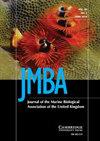原地温度和母体供养对鞘翅目金眼鲷全年种群中的中体向多体过渡的影响
IF 0.9
4区 生物学
Q3 MARINE & FRESHWATER BIOLOGY
Journal of the Marine Biological Association of the United Kingdom
Pub Date : 2024-07-30
DOI:10.1017/s0025315424000468
引用次数: 0
摘要
我们研究了环境条件是如何转化为 Aurelia aurita 从触角到息肉生命阶段的繁殖成败的。这项研究考察了(i) 介壳虫幼虫和多角体的定居成功率和发育在一年中的变化,(ii) 温度在决定幼虫成功定居和多角体生长中的作用,以及 (iii) 母体供给在幼虫成功定居和多角体生长中的影响。2019年2月至12月期间,每月从英国霍尔沙湖采集鳉鱼。栉水母幼虫在模拟采集时的原地温度和盐度条件下沉降。在各处理中,8月份采集的栉水母沉降速度最快。早期发育率(8触手)明显高于后期生长率(8触手),并且与温度呈正相关,与后期生长率不同。作为母体供养指标的触角长度在一年中变化很大。2019 年 7 月,气温异常升高的同时,浮游幼虫在水体中停留的时间也增加了。通过增加温度异常的发生率来提高温度,使其超过热极限,很可能不利于幼虫的沉降,并间接影响温带多角体种群的补充。本文章由计算机程序翻译,如有差异,请以英文原文为准。
Influence of in situ temperature and maternal provisioning on the medusa-to-polyp transition in a year-round population of the scyphozoan Aurelia aurita
We investigated how environmental conditions translate into reproductive success or failure in Aurelia aurita from the medusa to the polyp life stage. This study examined how: (i) settlement success and development of planula larvae and polyps vary across the year, (ii) the role of temperature in determining the successful settlement of larvae and growth of polyps, and (iii) the influence of maternal provisioning in the successful settlement of larvae and growth of polyps. Medusae were collected monthly from February to December 2019 from Horsea Lake, UK. Planula larvae were settled in conditions mimicking the in situ temperature and salinity of collection. For the individual treatments, planula collected in August settled most rapidly. Early development rates (<8 tentacles) were significantly higher than later growth rates (>8 tentacles) and were positively correlated with temperature, unlike later growth rates. Planula length, used as an indicator of maternal provisioning, varied significantly across the year. In July 2019, a high temperature anomaly coincided with an increased time spent by planula larvae in the water column. Increasing temperatures past thermal limits through the increasing occurrence of temperature anomalies is likely to be detrimental to larval settlement and indirectly to the replenishment of temperate polyp populations.
求助全文
通过发布文献求助,成功后即可免费获取论文全文。
去求助
来源期刊
CiteScore
2.30
自引率
8.30%
发文量
68
审稿时长
3-8 weeks
期刊介绍:
JMBA is an international journal, publishing original research on all aspects of marine biology. It includes pioneering work taking place today on major issues concerning marine organisms and their environment. Subjects covered include: ecological surveys and population studies of marine communities; physiology and experimental biology; taxonomy, morphology and life history of marine animals and plants; and chemical and physical oceanographic work. Included with 2010 online subscriptions: Marine Biodiversity Records.

 求助内容:
求助内容: 应助结果提醒方式:
应助结果提醒方式:


